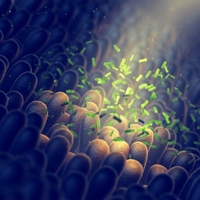
Reimagining fibre: The benefits and applications of Partially Hydrolysed Guar Gum (PHGG)
Your gut and digestive health greatly impact your well-being and quality of life. Adequate fibre intake is crucial to support a healthy microbiome (1).
Unfortunately, only 20% of Australians meet the suggested dietary target (SDT) of fibre (2).
If your diet lacks fibre, you may benefit from a convenient supplement like partially hydrolysed guar gum (PHGG).
What is PHGG?
PHGG is a soluble fibre derived from the guar bean plant Cyamopsis tetragonoloba (3).
Guar gum is often used as a thickening agent in food products. It is a type of polysaccharide comprised of long chains of sugar molecules, specifically mannose and galactose (4). Due to its high viscosity (ability to thicken), guar gum can exacerbate symptoms such as bloating and discomfort in those with digestive issues (4).
How is PHGG made?
PHGG is produced by partially hydrolysing guar gum with enzymes that break down the long-chain polysaccharides into shorter chains, making PHGG less viscous (5). This sets PHGG apart from other soluble fibres, as it is easier to digest while still retaining its high fibre content (5).
The shorter polysaccharide chains of PHGG help it to move slowly through your digestive tract, allowing beneficial gut bacteria to break it down more effectively, which enhances its prebiotic effects (6).
What are prebiotics?
Prebiotics are dietary fibres that promote the growth of beneficial bacteria in your gut (3). They resist digestion and undergo fermentation by bacteria in your large intestine, which leads to the production of short-chain fatty acids (SCFAs) and other beneficial by-products (7).
SCFAs serve as an energy source for your colon cells and help maintain a healthy gut environment (8). They have various health benefits, such as improving digestion, enhancing immunity, and reducing inflammation (8,9).
How can PHGG help my gut?
Consuming PHGG can be effective in the treatment of dysbiosis (an imbalance of gut bacteria) and small intestinal bacterial overgrowth (SIBO) as it nourishes and supports the growth and activity of beneficial bacteria, including Lactobacilli and Bifidobacteria, while reducing harmful bacteria levels (3,10,11,12).
It has a regulating effect on the digestive system and demonstrates efficacy in relieving both constipation and diarrhea often experienced in irritable bowel syndrome (IBS) (13,14,15,16). It may also reduce abdominal pain, bloating, flatulence, and indigestion (17,18,19).
The SCFAs produced through fermentation of PHGG help keep your gut healthy, support your metabolism, and make you feel fuller for longer, helping you stay satisfied throughout the day (8).
Can PHGG improve my mood and sleep?
PHGG has the potential to improve sleep, motivation, and mental health by suppressing harmful bacteria, reducing inflammation, and influencing the production of neurotransmitters including serotonin and dopamine in the gut (1).
The fermentation of PHGG by intestinal bacteria produces SCFAs that help regulate circadian rhythms, leading to improved sleep patterns (1).
How can PHGG enhance my immunity?
PHGG helps maintain a healthy gut environment by nourishing beneficial gut bacteria, which in turn assists in regulating immune function (20).
It may suppress cold-like symptoms through the production of SCFAs during its fermentation by gut bacteria (20).
Can PHGG improve blood sugar regulation?
PHGG may have a positive impact on blood sugar control. By slowing down the digestion and absorption of carbohydrates, PHGG helps regulate blood sugar levels, potentially benefiting those with diabetes or insulin resistance (21,22).
Can PHGG enhance weight loss?
PHGG may be particularly effective at reducing appetite and calorie intake (23).
It helps you feel fuller and more satisfied by slowing down the emptying of your stomach and increasing the production of hormones that signal satiety. This can reduce the urge to snack between meals and support weight loss (24).
Can PHGG support fertility?
Supplementing with PHGG may contribute to increased success in achieving pregnancy for women experiencing infertility by promoting the growth of beneficial gut bacteria, specifically bifidobacterium which plays a crucial role in enhancing fertility (25).
How can PHGG help my cardiovascular function?
PHGG has been found to reduce total cholesterol and LDL cholesterol (commonly known as bad cholesterol), while maintaining healthy HDL (or good) cholesterol levels (22,26). This makes PHGG a promising option for supporting heart health and managing cholesterol levels.
Can PHGG improve mineral absorption?
The prebiotic action of PHGG enhances the expression of proteins that aid iron absorption in the large intestine, leading to increased uptake. This helps to prevent anaemia and ensures you maintain optimal health (27).
Safety and dosage
PHGG is considered safe and well-tolerated, although some individuals may experience mild gastrointestinal side effects when consuming large amounts.
However, as it ferments slowly, it is less likely to cause gas and bloating compared to other prebiotics. It is also gluten-free and suitable for low-FODMAP diets (10).
This extremely unique fibre is odourless, easily dissolves in food and beverages, is stable in varying pH and temperature conditions and has no taste, making it very easy to consume (17).
It is advisable to start with a low dose and gradually increase it to assess personal tolerance. Starting slowly with 3g (1 teaspoon) and gradually increasing to 5g (2 teaspoons) daily can help alleviate potential undesirable effects.
Key takeaway
PHGG plays a vital role in improving your gut and digestive health. It also supports cardiovascular health, enhances sleep, regulates blood sugar levels, helps with weight management, promotes fertility, and improves iron absorption. Its odourless nature, easy dissolvability, and neutral taste make it a convenient and pleasant addition to your diet.
It’s important to consult with a healthcare provider before starting any supplements, as they may interact with medications or have other side effects.





